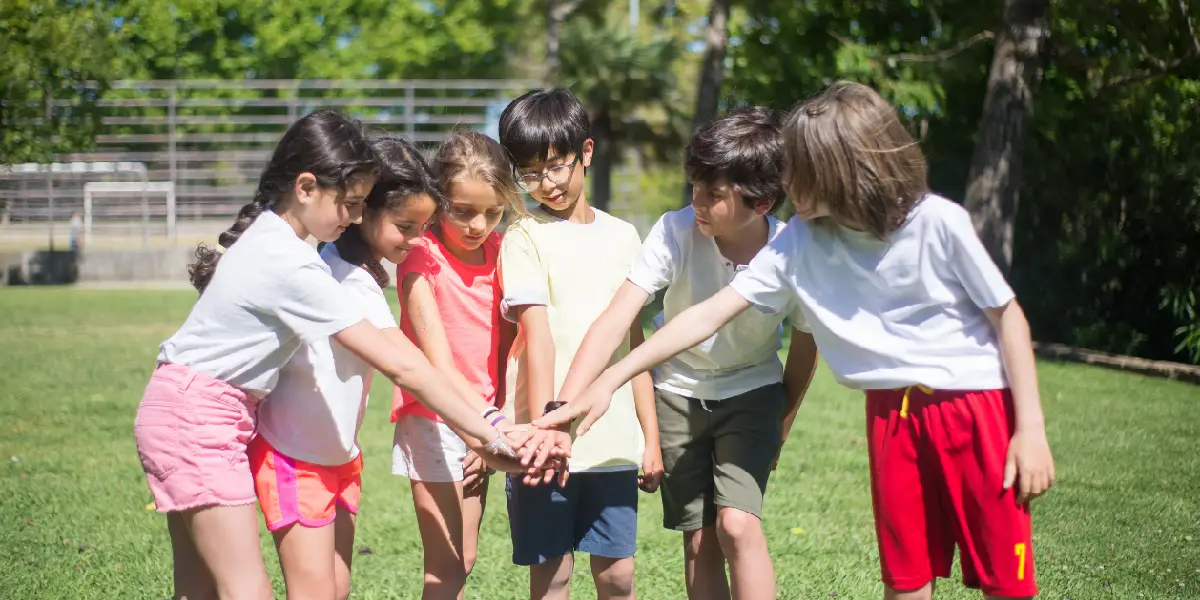10 Fun Team Building Games for Kids
Team building exercises are not just for adults. In fact, team building activities can be extremely beneficial for kids as well. These activities promote collaboration, communication, and problem-solving skills, while also fostering a sense of unity and camaraderie among children. Whether it’s for a classroom, a sports team, or a group of friends, team building games can be a fun and engaging way to bring kids together. In this article, we will explore the importance of team building for kids and showcase the top 10 games that are guaranteed to bring a smile to their faces.
10 Team Building Games for Kids
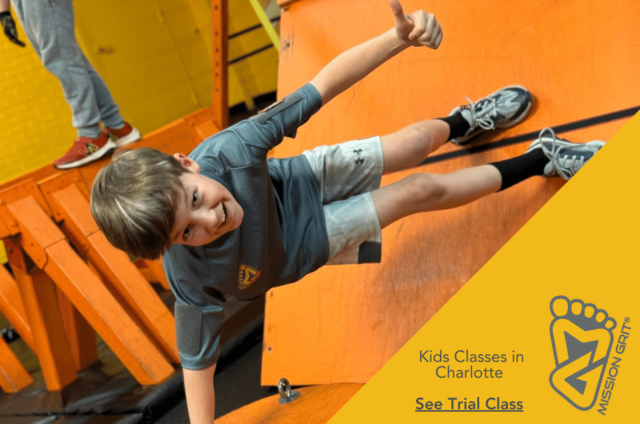
Understanding the Importance of Team Building for Kids
Team building activities for kids serve a variety of purposes. Most importantly, they help children develop essential social skills. By participating in team activities, kids learn to work together, understand the importance of collaboration, and develop empathy towards others. Moreover, these games promote communication skills, as kids are encouraged to express their thoughts and ideas with their teammates. Through team building exercises, children also become more aware of their role within a group, learning to share responsibilities and cooperate towards a common goal.
Team building games for kids not only provide a fun and engaging environment but also offer numerous benefits that contribute to their overall development. These activities go beyond simply playing and having a good time. They create opportunities for children to learn and grow in various aspects of their lives.
Enhancing Social Skills through Games
One of the major benefits of team building games for kids is that they enhance social skills. By interacting with their peers in a structured environment, children learn to build relationships, understand social cues, and develop empathy. These games create a safe space for kids to practice communication and cooperation, which are crucial skills they will need throughout their lives.
Games like “Human Knot” encourage physical closeness and cooperation, allowing kids to break down barriers and build trust in each other.
As they intertwine their arms and work together to untangle the knot, they learn the importance of communication and problem-solving. Similarly, “Relay Races” foster communication and coordination, as kids need to work together and strategize to win the race. This not only improves their physical abilities but also teaches them the value of teamwork and collaboration.
Boosting Confidence and Cooperation
In addition to enhancing social skills, team building activities also boost confidence and cooperation among kids. Games like “Treasure Hunt” require children to work as a team to solve puzzles and find hidden treasures. As they successfully complete challenges and achieve their goals, kids gain a sense of accomplishment and feel more confident in their abilities.
Moreover, these activities help children understand the importance of cooperation and teamwork, as they realize that they can achieve more together than individually. Through collaborative efforts, kids learn to trust their teammates, rely on each other’s strengths, and overcome obstacles as a unified group. This not only strengthens their bond but also instills in them a sense of responsibility towards their team members.
Team building activities for kids are not just about playing games; they are about fostering personal growth, building relationships, and developing important life skills. By engaging in these activities, children learn to navigate social dynamics, communicate effectively, and work towards common goals. These skills will benefit them not only in their childhood but also in their future endeavors as they become responsible and successful individuals.
Top 10 Team Building Games for Kids
Now that we understand the importance of team building for kids, let’s explore the top 10 games that are perfect for fostering collaboration and team spirit. These games are not only fun and engaging but also provide valuable learning opportunities for children.
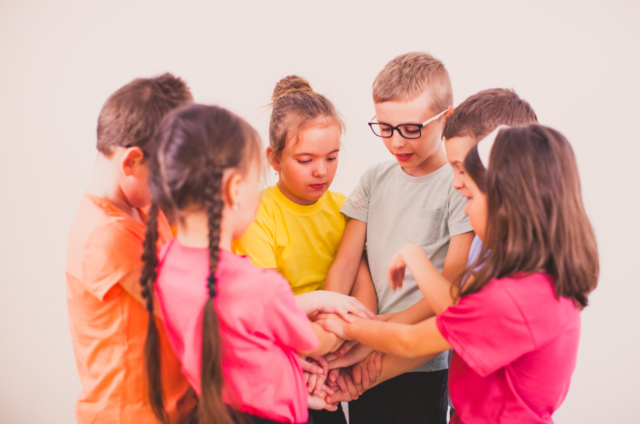
Game 1: Human Knot
One of the classic team building games for kids is the “Human Knot”. In this game, participants stand in a circle and hold hands with two people across from them. The objective is to untangle the knot without letting go of each other’s hands. This game requires communication, problem-solving, and teamwork.
As the game progresses, the participants will find themselves intertwined in a complex knot. They will need to strategize and communicate effectively to untangle themselves. This game not only promotes teamwork but also enhances spatial awareness and critical thinking skills. The sense of accomplishment when the knot is finally untangled boosts the team’s morale and confidence.

Game 2: Treasure Hunt
A popular game that combines adventure and teamwork is the “Treasure Hunt”. Kids are divided into teams and provided with clues and a map to find hidden treasures. This game encourages children to work together, think critically, and communicate effectively to solve puzzles and discover the hidden treasures.
During the treasure hunt, teams will need to collaborate and delegate tasks to maximize their chances of success. They will have to brainstorm ideas, interpret clues, and navigate through different obstacles. This game not only fosters teamwork but also enhances problem-solving, decision-making, and leadership skills.
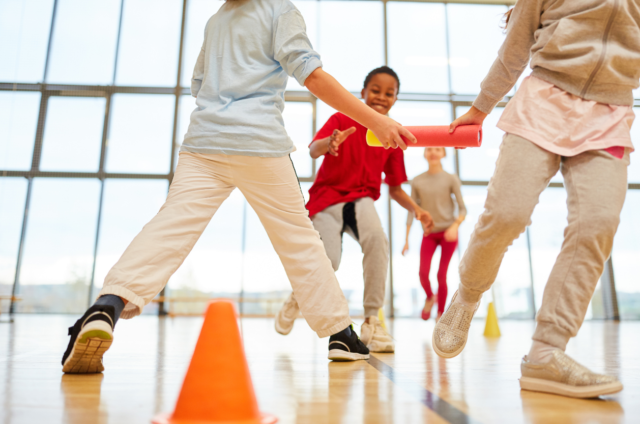
Game 3: Relay Races
Relay races are not only fun but also promote teamwork and coordination. In this game, kids are divided into teams and race against each other to complete a series of tasks. They need to work together, pass the baton, and collaborate efficiently to win the race. Relay races teach kids the importance of working together towards a common goal.
During the relay race, each team member will have a specific role and responsibility. They will need to communicate effectively, synchronize their movements, and support each other to achieve victory. This game not only strengthens teamwork but also improves communication, time management, and adaptability skills.
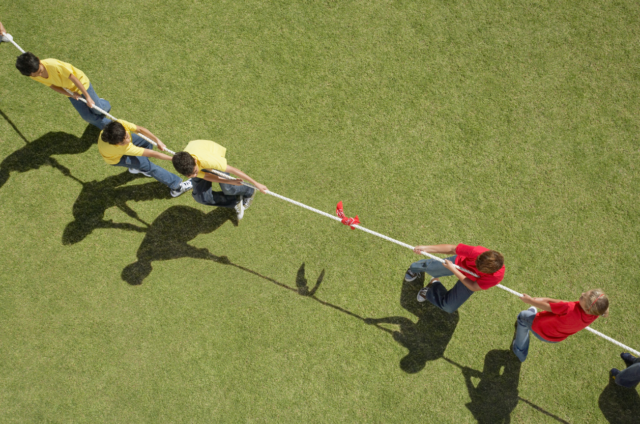
Game 4: Tug of War
Tug of War is a classic team building game that encourages teamwork, strategy, and strength. Kids are divided into two teams and try to pull the rope towards their side. This game teaches children the importance of cooperation, strategy, and effective communication.
During the intense tug of war battle, teams will need to develop a strategy and work together to overpower their opponents. They will learn the significance of coordinated efforts, clear communication, and adapting their tactics based on the situation. This game not only builds physical strength but also enhances teamwork, leadership, and decision-making skills.
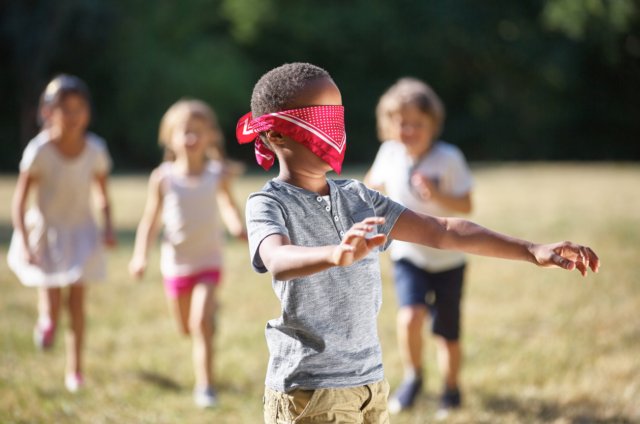
Game 5: Blindfold Obstacle Course
The blindfold obstacle course is a challenging and exciting game that requires trust and communication. One child is blindfolded, while their teammates guide them through an obstacle course using only verbal instructions. This game helps kids develop trust, active listening skills, and effective communication.
As the blindfolded child relies solely on their teammates’ instructions, trust becomes a crucial element in this game. The teammates must provide clear and accurate instructions, and the blindfolded child must trust and follow their guidance. This game not only strengthens trust but also improves communication, problem-solving, and teamwork skills.

Game 6: Tower Building Challenge
The tower building challenge is a game that encourages creativity, problem-solving, and collaboration. Kids are given a limited number of materials and must work together to build the tallest tower within a specified time. This game not only promotes teamwork but also allows children to think critically and explore different solutions.
During the tower building challenge, teams will need to brainstorm ideas, allocate resources effectively, and work together to construct a stable and impressive tower. They will learn the importance of effective communication, adaptability, and creativity in achieving their goal. This game enhances teamwork, critical thinking, and innovation skills.
How to Play a Tower Building Challenge

Game 7: Egg Drop Challenge
The egg drop challenge is a fun and engaging game that requires creativity and teamwork. Kids are given materials like straws, tape, and paper and must design a contraption that can protect an egg from breaking when dropped from a height. This game encourages problem-solving skills, collaboration, and creativity.
During the egg drop challenge, teams will need to brainstorm innovative ideas, design and construct their egg protector, and test it by dropping it from a predetermined height. They will learn the importance of collaboration, critical thinking, and resourcefulness in finding the best solution. This game not only promotes teamwork but also enhances problem-solving, creativity, and engineering skills.
How to Play Egg Drop Challenge

Game 8: Sack Race
Sack races are a classic outdoor game that promotes physical activity and teamwork. Kids hop inside a sack and race against other teams towards the finish line. This game teaches coordination, cooperation, and the importance of working together as a team.
During the sack race, teams will need to synchronize their movements, coordinate their hops, and support each other to reach the finish line as quickly as possible. They will learn the significance of teamwork, communication, and trust in achieving success. This game not only builds physical coordination but also enhances teamwork, communication, and perseverance skills.

Game 9: Balloon Pop Race
The balloon pop race is a high-energy game that requires coordination and cooperation. Kids form teams and must pop balloons by sitting on them. However, they can only pop the balloons by working together, stepping on the balloons simultaneously. This game fosters teamwork and effective communication.
During the balloon pop race, teams will need to synchronize their movements, communicate effectively, and coordinate their actions to pop as many balloons as possible within a given time. They will learn the importance of collaboration, trust, and clear communication in achieving their goal. This game not only promotes teamwork but also enhances coordination, communication, and problem-solving skills.

Game 10: Puzzle Solving Race
This game combines problem-solving and teamwork. Kids are divided into teams and are given a puzzle to solve. The team that solves the puzzle first wins the race. This game encourages critical thinking, collaboration, and effective communication.
During the puzzle solving race, teams will need to work together, analyze the puzzle, and come up with a solution as quickly as possible. They will learn the importance of effective communication, division of tasks, and leveraging each team member’s strengths. This game not only enhances problem-solving skills but also promotes teamwork, communication, and strategic thinking.
Tips for Organizing Team Building Games
Organizing team building games can be a fun and rewarding experience for both kids and adults. It not only promotes teamwork and cooperation but also helps in developing essential skills such as communication, problem-solving, and leadership. However, to ensure a successful and enjoyable experience, there are a few factors that need to be considered.
Choosing the Right Game
When selecting team building games for kids, it’s important to take into account their age range, interests, and physical abilities. Different age groups have different developmental stages, and it’s crucial to choose games that are appropriate for their level of understanding and capability. For younger children, games that focus on simple tasks and cooperation can be ideal, while older kids may enjoy more complex challenges that require strategic thinking and decision-making.
Furthermore, it’s essential to ensure that the chosen games are both fun and challenging. Games that are too easy may result in boredom, while games that are too difficult may lead to frustration. Striking the right balance is key to keeping the participants engaged and motivated throughout the activity.
Preparing the Game Setup
Once you have chosen the right game, it’s time to prepare the game setup. This involves setting up the game area, providing clear instructions, and ensuring safety precautions are in place. The game area should be spacious enough to accommodate all the participants comfortably, with enough room for movement and interaction.
Before starting the game, it’s crucial to explain the rules and objectives to the participants. This will help avoid any confusion or misunderstandings during the activity.
Providing a demonstration or a practice round can also be beneficial, as it allows the participants to familiarize themselves with the game mechanics and gain confidence.
Additionally, make sure to check the game equipment and ensure that everything is in proper working condition. If any props or materials are required, have them ready beforehand to avoid any delays or interruptions during the game.
Ensuring Safety During the Games
Safety should always be a top priority when organizing team building games. Before the game starts, thoroughly inspect the game area for any potential hazards or obstacles that could pose a risk to the participants. Remove any sharp objects, slippery surfaces, or tripping hazards to create a safe environment.
Furthermore, it’s important to provide appropriate supervision throughout the activity. Assigning trained staff or volunteers to monitor the participants and ensure their safety can help prevent accidents or injuries. They should be readily available to address any concerns or emergencies that may arise during the games.
Moreover, it’s essential to modify the games to fit the age and physical abilities of the participants. For example, if you have a group of young children, you may need to adjust the game rules or provide additional support to accommodate their capabilities. By doing so, you can minimize the risk of injuries and create a more inclusive and enjoyable experience for everyone involved.
Organizing team building games can be a fantastic way to foster camaraderie, boost morale, and create lasting memories. By considering these tips and taking the necessary precautions, you can ensure that your team building games are not only fun and engaging but also safe and rewarding for all participants.
The Benefits of Regular Team Building Activities
Regular team building activities have numerous benefits for kids. Not only do these activities provide a fun and engaging experience, but they also offer a wealth of opportunities for personal growth and development.
Improved Communication Among Kids
Through these activities, kids learn to express their thoughts, listen actively, and understand different perspectives. This improved communication extends beyond the games and positively impacts their relationships outside of the activity.
Team building games encourage children to communicate with their peers effectively.
Moreover, by engaging in team building activities, children have the chance to interact with individuals from diverse backgrounds and personalities. This exposure allows them to develop empathy and understanding, as they learn to navigate through different communication styles and adapt to various ways of expressing ideas.
Development of Leadership Skills
Team building games provide opportunities for children to practice leadership skills. As they participate in group activities, kids learn how to delegate tasks, make decisions, and motivate their team members. These activities empower children to take charge and develop essential leadership qualities.
Furthermore, team building activities often involve collaborative projects or challenges that require effective teamwork and cooperation. By taking on leadership roles within these activities, children learn the importance of clear communication, organization, and delegation. These skills are not only valuable in team settings but also in various aspects of their lives, such as school projects, extracurricular activities, and future careers.
Encouraging Creativity and Problem Solving
Team building games foster creativity and problem-solving skills in children. These games often present unique challenges that require kids to think outside the box, come up with innovative solutions, and collaborate to overcome obstacles.
By engaging in these activities, children are encouraged to explore different approaches and perspectives, allowing their creativity to flourish. They learn to embrace new ideas, think critically, and find creative solutions to problems. This not only enhances their problem-solving skills but also nurtures their ability to adapt to unexpected situations and think on their feet.
Additionally, team building activities provide a safe and supportive environment for children to take risks and learn from their mistakes. This fosters a growth mindset, where children understand that failure is a stepping stone towards improvement and success.
In conclusion, regular team building activities offer a range of benefits for kids. From improved communication and leadership skills to enhanced creativity and problem-solving abilities, these activities provide a holistic platform for personal growth and development. By participating in team building activities, children not only have fun but also acquire valuable skills that will benefit them throughout their lives.
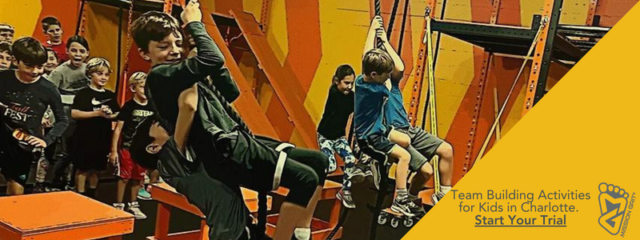
Conclusion: Fostering Team Spirit Through Fun Games
Team building games for kids are a fantastic way to promote collaboration, communication, and unity among children. These games not only provide a fun and engaging experience but also teach valuable life skills. By understanding and appreciating the importance of team building activities, parents, teachers, and coaches can help children develop essential skills that will benefit them in all aspects of their lives. So gather the kids, organize a team building activity, and watch as they grow and thrive in a supportive and cohesive environment.

